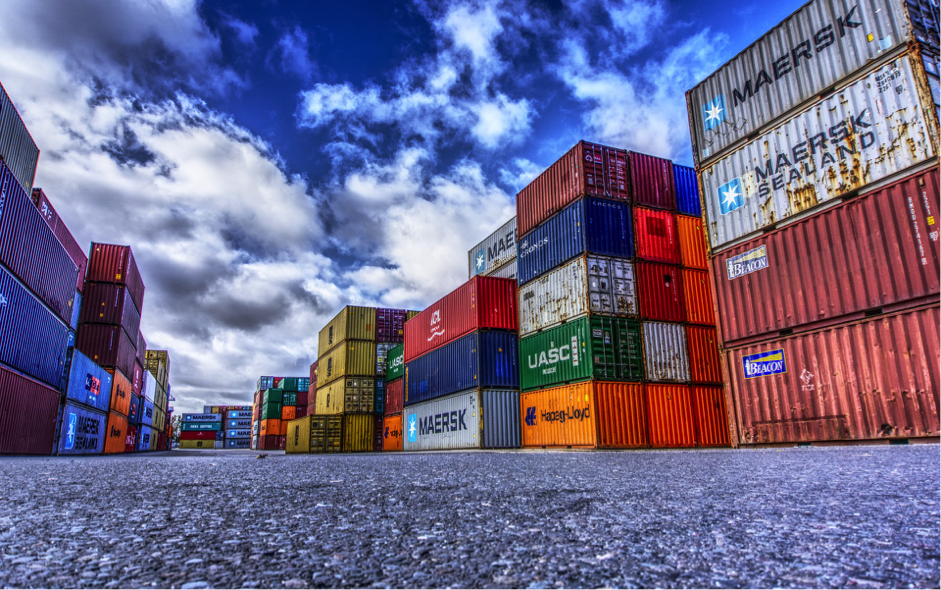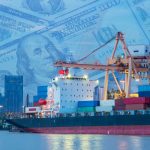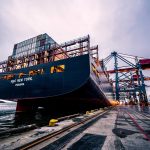Record Imports & No More Overcapacity – Are We Really Seeing a “New Normal” in International Shipping?
As the Ports of Los Angeles and Long Beach hit record volumes of imports for March and freight rates reached a new peak, experts are telling us that the days of overcapacity, and the lower freight rates they bring, are over.
First, let’s look at the record-setting volume.
Ports of Los Angeles & Long Beach’s Record March
Greg Miller reports in American Shipper:
Los Angeles handled 957,599 twenty-foot equivalent units (TEUs) in March, up 113% year on year — the highest March number in the port’s history….
…
“That’s a big number for a peak month like September or October. But we’ve never seen volume like this in the first half of the year.”
Miller was quoting Port of Los Angeles Executive Director Gene Seroka at the end there.
Eric Kulisch reported in American Shipper:
The Long Beach port authority on Thursday said its terminals handled 840,387 twenty-foot equivalent units (TEUs) last month, surpassing the previous high of 815,885 set in December. March is normally one of the slowest months for maritime trade, as supply chains relax from order peaks associated with U.S. and Chinese holidays.
In Tuesday’s post, we talked about freight rates hitting new highs. In fact, freight rates have been so high for so long now, some shippers are starting to wonder if they’ll ever come down.
Shipping Expert Talks New Normal
Lars Jensen, CEO & Partner of SeaIntelligence Consulting, wrote an article for the Journal of Commerce (JOC) that states right in the title “shippers face a ‘new normal’ of more balanced capacity.”

We’ll get to that balanced capacity part in a bit. First, I hate the phrase “new normal.” While it doesn’t have to be all negative, “new normal” has been used a ton over the last year to get people to accept agenda-driven narratives, reduction of freedoms, and political power grabs. I do have to admit, however, the main message of Jensen’s “new normal” article is likely true: gone are the days of severe overcapacity in ocean freight shipping.
Carriers creating overcapacity in their competition with each other and – as Jensen points out – to attain scale benefits drove freight rates down. In fact, over the last decade, I’ve written many posts in Universal Cargo’s blog about record low freight rates while pointing out carriers’ inability to manage capacity as a leading cause of those low rates shippers enjoyed. Jensen, in his article, went so far as to say, “The ‘Old Normal’ has for decades been an abundance of capacity.”
However, with the onset of dominant carrier alliances growing to control the industry since 2014, I’ve been warning the shrinking of competition would eventually result in higher freight rates for shippers. When the pandemic hit in 2020, we saw the three controlling alliances flex their muscles and squash capacity – well below the initially reduced demand the pandemic caused – driving freight rates way up.
We’d actually already seen more capacity discipline from carriers in the year or two leading up to 2020. However, never before had they seen the kind of price points and profits controlling capacity and pushing freight rates up could bring before now. Carriers will certainly strive to maintain this kind of profit or something close to it, but does that mean this is truly the “new normal”? Will shippers never see rates come back down because carriers have so thoroughly controlled capacity?
Demand Is Still a Factor
Demand is, of course, a huge factor in the incredibly high freight rates we’re seeing. It is also a factor in carriers’ ability to control capacity balance. What happens when demand finally falls? And it is hard to imagine it won’t eventually take a very large tumble. Despite being built on top of a strong economic foundation before the pandemic hit, demand is artificially high right now, propped up by government stimuli and a year of people saving money because they were unable to go out or travel due to lockdowns.
Yes, carriers could blank (cancel) hundreds of sailings like they did when the pandemic first hit. However, for the better part of a year, carriers have added capacity, and have even done more ship ordering, in response to all the demand they are seeing. After months and months of record to near record volume, it won’t be as easy to match capacity to a sudden and steep drop in demand.
Larger ships, even megaships, are pervasive in the international shipping industry. With the massive ships, many of which able to transport well over 20,000 TEU on a sailing, there is a level that demand could drop to that carriers would struggle to avoid well exceeding with capacity.
Additionally, there are still some signs of capacity races from carriers. I’ve written a couple Universal Cargo blog posts over the last couple years about MSC buying ships, increasing its capacity, and threatening to overtake Maersk in terms of fleet capacity. There’s even been some bitterness between the 2M Alliance members over it. MSC is back in international shipping headlines again for being set to replace Maersk as the world’s largest container line, such as in this article from Shipping Watch. Of course, MSC had been projected to surpass Maersk earlier than the current projections, which is just one indication Maersk may not give up its thrown without a fight.
The MSC-Maersk rivalry is just an example to show there is still a capacity competition that exists between carriers. While we likely will see much more control over capacity in the future, like Jensen says, it is not impossible to think there will be times that the industry will still struggle with overcapacity. Such times should be fewer and further between, but when they happen, they will be accompanied by downward pressure on freight rates.
Capacity Balance Is a Strong Phrase
I said I’d get back to that “balanced capacity” phrase Jensen used in his article. Yes, capacity is more balanced from the carriers’ point of view, as they’re not suffering from severe overcapacity. However, I don’t like the use “capacity balance” when describing what’s been happening in international shipping over the last year.
Right now, we’re getting right around the time of year that carriers dropped capacity well below market demand last year. That’s a capacity imbalance that pushed freight rates way up and angered shippers, who accused carriers of profiteering off the pandemic. The hundreds of blanked sailings carriers instituted a year ago also began a huge imbalance of shipping containers that persists to this moment.
The way carriers have been dealing with this imbalance of shipping containers has been by limiting the service and capacity offered to U.S. exporters, shipping empty containers back to Asia instead of containers full of U.S. goods. American agricultural exporters have especially suffered from this and have gone so far as to plead to President Biden to do something. Not surprisingly, no action has been seen from the Biden Administration on the issue.
Carriers continue to prioritize shipping empty containers back to Asia over supplying U.S. exporters with them. Miller’s American Shipper article provides detail from the Port of Los Angeles’ executive director on the continued imbalance of shipping empty containers over loaded ones:
“The madness continues with the empties,” said Seroka, referring to outbound empty container volumes loaded on ships in Los Angeles in March.
Last month saw the highest-ever number of empties loaded on ships in Los Angeles. The four-to-one gap between empty export containers and full export containers “is the highest gap we’ve seen in recent times,” he added.
Asked why this was occurring, he responded, “It’s quicker [for ocean carriers] to get the empties onto the ships and to the next point of origin in Asia to recycle them and have them come back as imports than it would be for the additional transit time to reach U.S. exporters here and then deliver exports to Asia consignees on the other side of the Pacific.
“So, they’re trying to cut down the transit time and catch up on the massive orders for imports and the next round to come to the U.S.”
Conclusion
Freight rates are high, as is cargo volume, especially when it comes to importing from China, and Asia in general. Volume and freight rates look like they’ll remain high for most of the year, making it through this traditionally slower part of the year and into the peak season, when traditional swells in cargo should carry high freights and volume forward for a few more months.
Carriers, with their competition-reducing alliances, have gotten much better at controlling capacity. This makes it likely that when volume does finally come down, freight rates won’t drop as dramatically as they have in the past.
A sudden and severe drop in capacity could create a situation in which carriers find it more difficult to avoid overcapacity. Such an outcome is not at all out of the realm of possibility, especially with the worries of the big stimulus bubble that’s been created popping and causing a recession or crash. In such outcomes, freight rates should fall.
Carriers appear to have no qualms in creating capacity imbalances so long as they result in profits. That means shippers, especially but not limited to U.S. exporters, could continue to find it harder to obtain space for their cargo well into the future.
In the meantime, shippers would be wise to follow Jensen’s advice to be prepared for continued higher freight rates and more difficult shipping circumstances than have been seen in years past:
As such, shippers – big and small – need to re-assess their supply chain strategies for the post-pandemic new normality and find how they best balance between transactional costs, supply chain speed, supply chain flexibility, and supply chain resilience.




